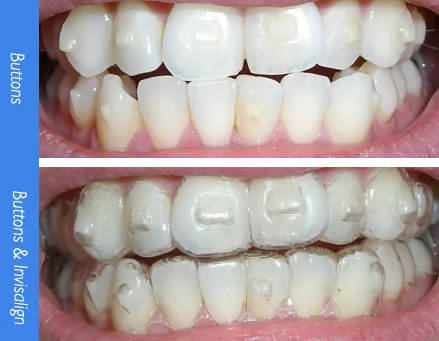Invisalign vs. Traditional Dental braces: Which Alternative Is Right for You?
When taking into consideration orthodontic therapy, the selection between Invisalign and standard dental braces offers several crucial elements that merit mindful examination. Invisalign uses a very discreet choice with removable aligners, while traditional dental braces offer an extra noticeable yet efficient option for severe imbalance.
Overview of Treatment Choices

On the other hand, typical dental braces contain steel braces and cords that are bonded to the teeth. This method uses continuous pressure in time to achieve positioning. While efficient for complex orthodontic problems, conventional braces need routine sees for adjustments and can posture challenges in preserving oral health because of the trouble of cleaning up around wires and brackets.
Both choices have their merits, and the choice often rests on specific dental conditions, lifestyle choices, and client compliance. Ultimately, speaking with an orthodontic expert is crucial for figuring out the most appropriate therapy plan tailored to individual requirements. Recognizing the nuances of each choice can significantly influence the general success of orthodontic therapy.
Aesthetic Considerations
A substantial aspect influencing the option between Invisalign and typical braces is the visual appeal each treatment uses. Invisalign aligners are crafted from clear plastic, making them basically invisible when worn.
On the other hand, traditional braces include steel brackets and wires, which can be a lot more recognizable. While developments in orthodontic modern technology have led to the development of smaller braces and colored elastics, traditional dental braces still keep a more obvious profile. For some people, the exposure of dental braces might prevent them from seeking necessary therapy.
Eventually, the choice between Invisalign and typical braces might pivot on individual choices concerning aesthetics. Patients who focus on discernment commonly favor Invisalign, while those who are much less worried concerning exposure may go with conventional braces. Understanding the visual ramifications of each choice is essential for making an informed decision that aligns with one's way of living and preferences.
Comfort and Convenience

In terms of convenience, Invisalign aligners are detachable, allowing clients to appreciate their preferred foods without constraint and maintain optimal oral hygiene. Brushing and flossing are streamlined, as the aligners can be secured throughout these routines, whereas typical braces need mindful steering around cords and braces.
In comparison, typical dental braces necessitate routine changes, making them less hassle-free for those with busy schedules. On the whole, the comfort and convenience of Invisalign make it an appealing choice for several individuals seeking orthodontic treatment.
Treatment Duration and Performance
While both Invisalign and standard braces are efficient in remedying oral imbalances, the period of therapy can vary significantly between the 2 choices. Usually, Invisalign treatment can take anywhere from 12 to 18 months, depending on the complexity of the situation. The clear aligners work by gradually shifting teeth right our website into their desired placements, and normal follow-ups with an orthodontist assistance make certain progression stays on course.
On the other hand, conventional dental braces typically call for a longer commitment, generally varying from 18 months to 3 years. This is due to their fixed nature and making use of cables and braces, which can be a lot more effective for severe misalignments and complex instances (Invisalign). The therapy efficiency of traditional braces is well-documented, as they allow for precise changes and greater control over tooth motion
Inevitably, the selection in between Invisalign and conventional braces might hinge on both the expected therapy period and the certain oral concerns handy. Consulting with an orthodontist is essential, as they can supply tailored recommendations based upon private requirements, guaranteeing the selected approach aligns with desired results and timeframes.
Price Contrast and Insurance Alternatives
Expense plays a substantial role in the decision-making process for individuals considering orthodontic treatment, whether selecting Invisalign informative post or conventional braces. On average, the expense of Invisalign ranges from $3,000 to $8,000, while standard dental braces normally set you back between $2,000 and $6,000. Variables influencing these prices include the intricacy of the instance, the duration of treatment, and geographical place.
Insurance protection can substantially affect out-of-pocket expenses. Several dental insurance policy strategies supply partial insurance coverage for orthodontic therapies, yet the specifics can differ widely. It is vital for people to examine their insurance policies to determine the extent of protection for either alternative. Usually, standard dental braces might be extra regularly covered by insurance strategies contrasted to Invisalign, which some insurers classify as a cosmetic treatment.
Additionally, a number of orthodontic methods supply adaptable layaway plan, making both treatment options more obtainable. People ought to ask about prospective funding alternatives and price cuts for in advance settlements. Reviewing the overall expense, consisting of insurance coverage advantages and layaway plan, is important for making a notified decision that straightens with both visual choices and budget plan considerations.

Final Thought
In summary, the choice in between Invisalign and typical braces hinges on several aspects, including aesthetic preferences, convenience, treatment period, and cost. Invisalign provides a discreet, detachable option that assists in dental hygiene and dietary versatility, while standard dental braces might be preferable for complex oral concerns and frequently come at a reduced rate factor. Ultimately, assessment with an orthodontist is essential to analyze specific circumstances and identify the most ideal therapy alternative for attaining optimum oral positioning.
When taking into consideration orthodontic therapy, the option in between view it now Invisalign and conventional dental braces provides a number of crucial elements that warrant mindful assessment.Contrasting Invisalign and conventional dental braces exposes unique treatment alternatives for orthodontic improvement.While both Invisalign and typical dental braces are efficient in correcting oral misalignments, the duration of treatment can differ considerably in between the two choices.Price plays a substantial role in the decision-making process for individuals thinking about orthodontic therapy, whether choosing for Invisalign or traditional dental braces.In summary, the choice in between Invisalign and standard braces hinges on numerous elements, including visual preferences, convenience, treatment duration, and cost.